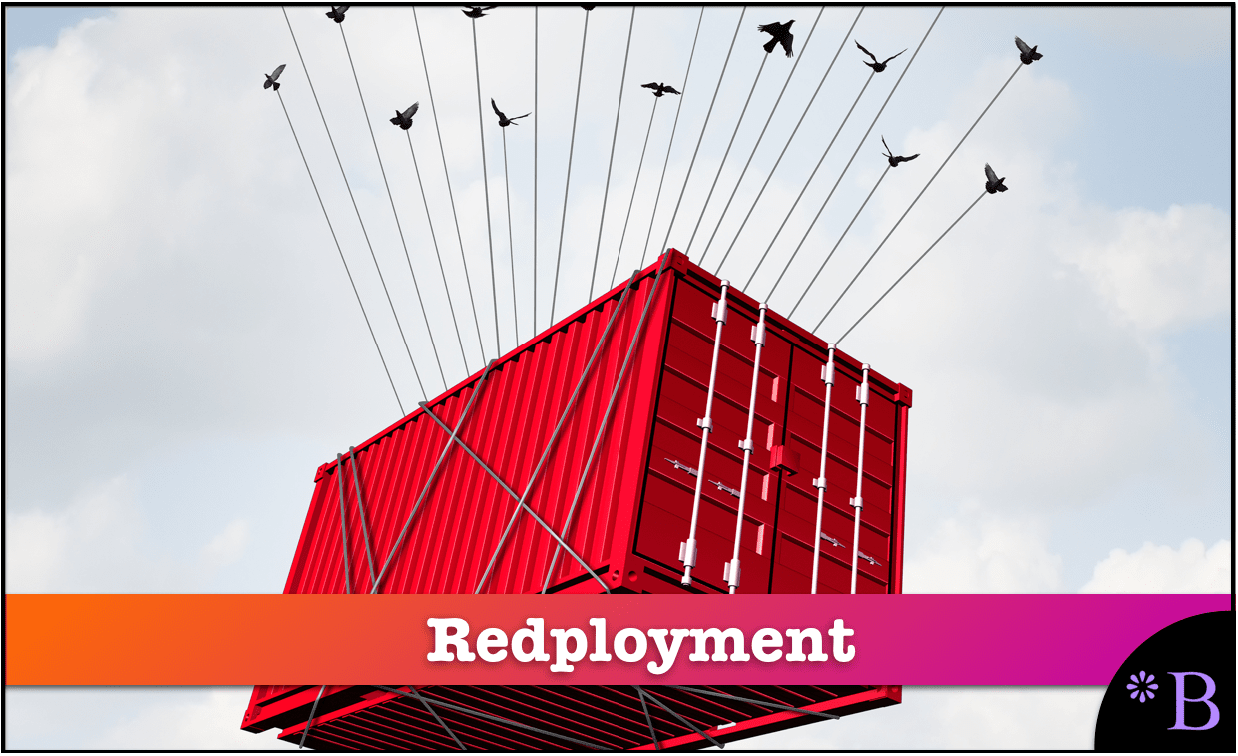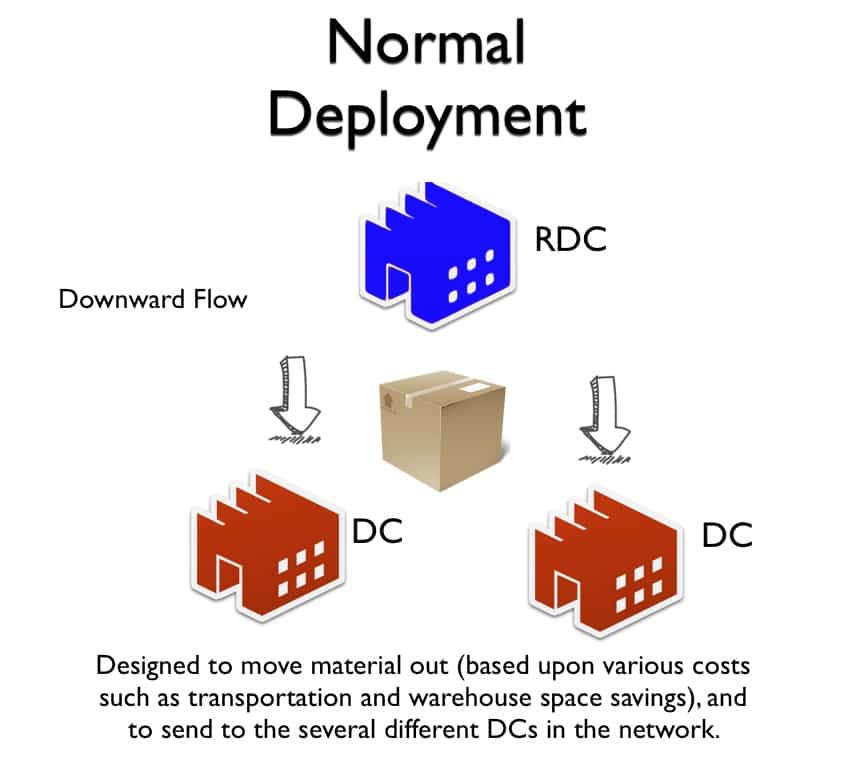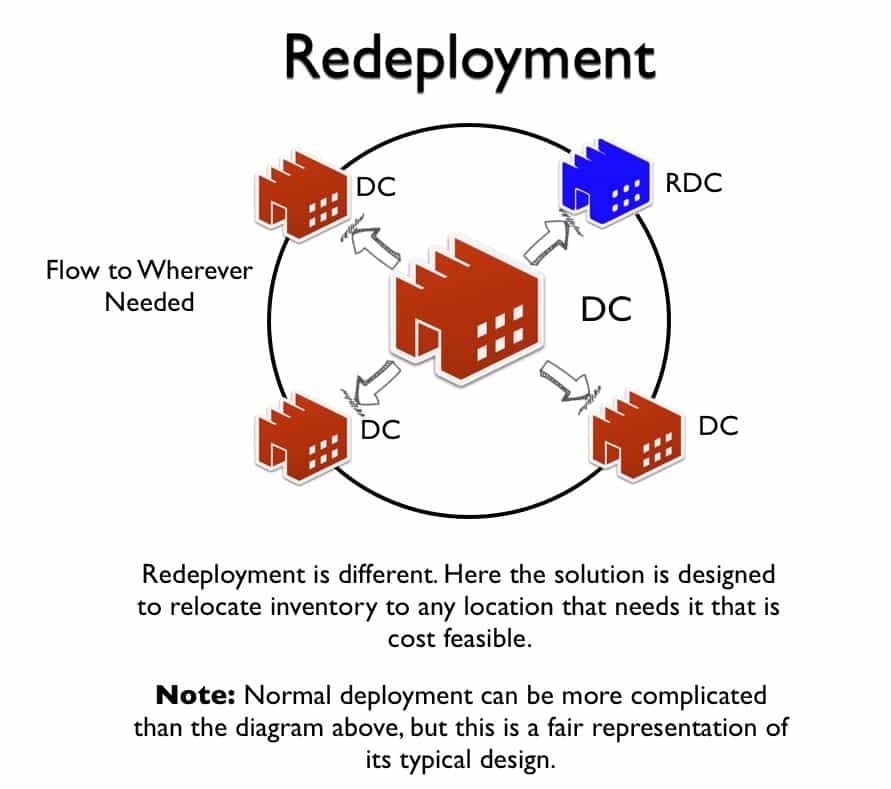How to Understand Redeployment for Slow Moving Inventory
Executive Summary
- Redeployment is a planning thread that repositions inventory to locations where it has a higher likelihood of being consumed.
- Redeployment applies to more to slow-moving inventor and can be considered a form of inventory analysis and a way of reducing obsolete inventory.
- Redeployment differs by product type.

Introduction to Redeployment
Redeployement is the least used, but still quite important supply planning runs. You will learn the reason for redeployment and how rededployment can be activated.
See our references for this article and related articles at this link.
What is Redeployment?
Redeployment is the redistribution of stock that is already in a forward location in the supply network at an inventory position to another forward location or back to the parent location. I can also be called inventory re-balancing and sometimes inventory repositioning, and is the least well known of the major supply planning threads.
To understand redeployment, it is helpful to contrast it to normal deployment.

The deployment follows a rigid flow of parent to children locations which is primarily designed to minimize logistics costs.

Redeployment is quite different because it means that the normal parent-child valid location-to-location relationships are in turned off, allowing any location to be shipped stock from any other location.
Redeployment can be considered the correction of an error in the deployment supply plan in that product was moved to a location that it was not consumed and has a lower probability of being consumed in the future at its present location than if transferred to a new location.
Redeployment can be considered the correction of an error in the deployment supply plan in that product was moved to a location that it was not consumed and has a lower probability of being consumed in the future at its present location than if transferred to a new location.
Redeployment as a Type of Inventory Analysis
Redeployment can be considered a type of inventory analysis because it means analyzing the inventory position in the system and making a determination which inventory should be moved where. Almost all companies end up with an inventory position which they would like to alter. Companies have people and groups that perform inventory analysis to determining
The most common types of inventory that falls into the redeployment category are slow moving inventory and obsolete inventory.
Slow Moving Inventory
Slow moving inventory is difficult to forecast, and the average inventory position of slow moving inventory is normally high versus its demand. In some cases, slow moving inventory should not be held at a particular location. In other cases, such as with service parts there may be no alternative because the inventory must be carried at a location to meet service goals.
Slow moving inventory is managed best when it can be “pooled.” This can mean that the slow moving inventory is aggregated to the larger distribution centers. Another way of pooling is through redeployment. Redeployment allows all the inventory in the network to be shared, but at the price of movement.
Slow moving inventory is increasingly being carried due to product proliferation. That is slow moving inventory is in many cases driven by marketing’s desire to have high numbers of SKUs. As this trend sees no sign of abating, redeploying slow moving inventory should be of rising interest to companies.
Obsolete Inventory
Companies have people and groups that perform inventory analysis to determining obsolete stock or obsolete inventory. Inventory obsolescence has several causes.
- One is product specific. That is the product only sellable (for its normal price or sometimes for any prices) for a period, and so the stock becomes obsolete when it does not sell at this time. But also a primary reason why an obsolete stock or obsolete inventory “goes bad” is because the inventory position is not transferred to a location where it can be consumed. In
Apparently, if the stock can eventually be sold without requiring its movement, then it may make sense to keep it at the present location. Inventory obsolescence is a primary driver for redeployment, as it can mean the company writing off the obsolete stock for nothing or some small fraction of its average sales price.
Slow Moving Inventory and Obsolete Stock
In some cases, the soon to be obsolete stock is not moved because the inventory analysis is not performed. In other cases the soon to be obsolete inventory is not transferred to a location where it has a higher probability of being consumed is because doing so would violate the company’s transportation budget cap. It is often the case that even though a mathematical inventory analysis can demonstrate an inventory position has a lower likelihood of becoming inventory obsolescence and would earn the company more money; the decision to reposition the stock is still not made. I have been surprised to see how politically complicated it becomes to move stock that has a high likelihood of inventory obsolescence. But also, most companies are still not familiar with software that could automate the inventory obsolescence analysis and stock redeployment inventory analysis.
Factors Applied for Redeployment Analysis
In this inventory analysis, one applies various factors such as:
- The forecast for the item at different locations.
- The current stock level and inventory position for an item at all the locations it is stocked (if the analysis is run open)
- The service level target at the different locations for the item.
- The cost of carrying the item.
- The transportation cost to move the item.
Another factor reinforcing the fact that redeployment is an inventory analysis is that many companies perform this redeployment as a stock analysis. That is without using any specialized software at all to determine what stock should be repositioned. In fact, there are few useful applications on the market for performing redeployment.
Different Redeployment for Different Products
Redeployment is an overlooked supply planning functionality on the part of non-MEIO software companies. Other supply planning methods focus on the initial deployment, but often not at all on redeployment. A case can be made that this is an oversight, as imperfect forecasts will require some percentage of the initial deployment to rationale at a later date. This is not only a matter of simply waiting and taking more inventory costs. The material can and does expire because it was never redeployed, and this means writing off both the cost of the item in addition to the carrying cost of the item until it expires.
How a product can be adjusted post-deployment greatly depends upon the product’s characteristics. Some items only have the opportunity to be sold in the same state but in a different location. Other items like paint can be re-manufactured and can be sold as entirely different colors (possibly a better selling color) This can mean moving the product from its inventory position twice.
- One to move it back to a manufacturing facility.
- Then moved a second time to forward locations in the supply network. Which may or may not be where the product originated. In this way, re-manufacture is very similar to the repair redeployment faced by service parts networks.
A Philosophical Opposition to Redeployment with Finished Goods Companies?
It sometimes appears that redeployment contradicts some supply chain decision makers at a philosophical level. I was once told by an executive that they did not want to redeploy their current inventory position, because as he put it:
What if they had to redeploy it yet again?
However, there is nothing to say that the initial deployment and the current stock position is correct or as it should be.
All anyone can do under conditions of uncertainty is apply probabilities. A certain percentage of all supply chain planning decisions will be “wrong,” but that should not prevent us from making due with imperfect information.
How Redeployment Compares Across the Various Supply Planning Methods
Redeployment is one of the strongest areas of functionality for MEIO vendors. It is correspondingly one of the weakest areas of functionality in all other supply planning methods which are.
- MRP/DRP
- Heuristics
- Order Allocation
- Cost Optimization
Sometimes those with little understanding of redeployment, but with a financial bias to utilize some specific cost optimizing supply planning application, will propose using a cost optimizer for redeployment.
The logic for cost optimizers which essentially compares the transportation costs to the costs of unfulfilled demand at the sending and receiving location, as well as the storage costs at the sending and storage locations, are also not designed for redeployment. Companies that attempt to use cost optimizers for redeployment will normally run into great limitations.
This a greatly underemphasized area of supply planning software development. Every client I have consulted with needs redeployment. The lack of enterprise software solutions is why this is a common area for custom development.
The History of Redeployment and Inventory Analysis
The original work on inventory optimization and multi echelon planning was developed for service parts network which needs redeployment. Many of the RAND Corporation papers that set the basis for modern MEIO had a strong emphasis on redeployment as this was a requirement of the US Air Force (the party paying for the research), and their airplane service network.
Conclusion
Redeployment is very far down on the list of most companies. That is unfortunate because it should not be and the opportunity to reduce inventory obsolescence, to reduce inventory holding cost and increase revenues is certainly there.
Service parts planning inventory optimization and multi echelon software companies have the strongest redeployment functionality.
In addition to having the functionality built-in, vendors have an advantage conceptually over non-inventory optimization and multi echelon vendors in redistribution. This is because of the traditional logic of deployment, which non-inventory optimization and multi echelon vendors attempt to use for redeployment such as fair share logic, does not translate appropriately for redeployment. The logic for cost optimizers which essentially compares the transportation costs to the costs of unfulfilled demand at the sending and receiving.

The Necessity of Fact Checking
We ask a question that anyone working in enterprise software should ask.
Should decisions be made based on sales information from 100% financially biased parties like consulting firms, IT analysts, and vendors to companies that do not specialize in fact-checking?
If the answer is “No,” then perhaps there should be a change to the present approach to IT decision making.